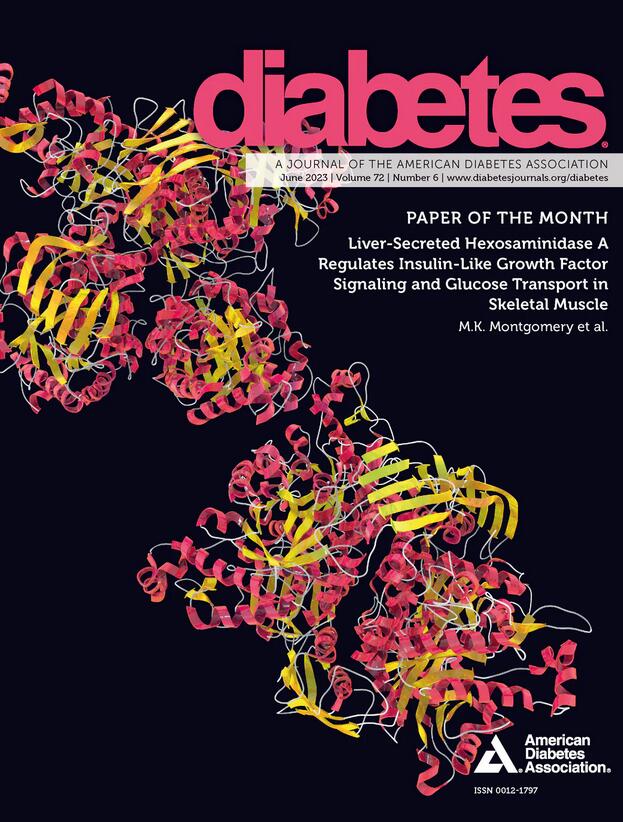1555-P:减少 80% 胰腺对 Beta 细胞功能和葡萄糖代谢的影响
IF 6.2
1区 医学
Q1 ENDOCRINOLOGY & METABOLISM
引用次数: 0
摘要
导言和目标:糖尿病通常是由于胰腺内分泌系统无法分泌足够的胰岛素来满足胰岛素需求而导致的。许多研究表明,当人类胰腺β细胞质量损失约为41%至65%时,就会出现糖尿病。近全胰切除术(NTP)是一种切除 80% 胰腺组织的外科手术。研究方法我们招募了 7 名受试者,他们在 NTP 之前和之后 3 个月接受了口服葡萄糖耐量试验 (OGTT) 和高血糖钳夹 (HC),然后接受精氨酸刺激。我们计算了 OGTT 期间葡萄糖(AUC-Glu)和胰岛素(AUC-Ins)反应的曲线下面积。因此,我们估算了β细胞葡萄糖敏感性(βCGS)和速率敏感性(RS),前者是β细胞功能的指标,后者是第一阶段胰岛素分泌的指标。此外,我们还计算了 HC 期间胰岛素反应曲线下的总面积(AUC-Itot)和精氨酸刺激胰岛素分泌曲线下的面积(AUC-Arg)。结果:与术前 OGTT 相比,我们观察到术后 OGTT 期间的平均血糖水平增加了 18%(AUC-Glu 19761 vs 23421 mg/dl-min),平均胰岛素浓度降低了 57%(AUC-Ins 6499 vs 2788 μU/ml-min p<0.05)。此外,我们还观察到,手术后,βCGS 降低了 36%(61.2 vs 38.7 pmol min-1m-2mmol-1L),RS 降低了 82%(763 vs 139 pmol m-2mmol-1L p<0.05)。HC 期间的胰岛素总分泌量和精氨酸刺激的胰岛素分泌量分别减少了 58.8% 和 64.7%(AUC-Itot 15776 vs 6489 μU/ml-min)(AUC-Arg 7144 vs 2520 μU/ml-min)。根据 ADA 诊断标准,7 名受试者中有 3 人患上了糖尿病。结论总之,尽管之前有报道称,80% 的 β 细胞质量损失并不总是足以导致高血糖。有必要进行更多的研究,以了解是什么机制在这些患者的葡萄糖耐量保持过程中发挥了补偿作用。披露 L. Soldovieri:无。G. Di Giuseppe:无。G. Ciccarelli:无。M. 布鲁内蒂无。A. Mari:顾问;礼来糖尿病公司。G. Quero:无:无。S. Alfieri:无。A. Giaccari:无。T. Mezza:无。本文章由计算机程序翻译,如有差异,请以英文原文为准。
1555-P: Effects of 80% Pancreas Reduction on Beta-Cell Function and Glucose Metabolism
Introduction and Objectives: Diabetes typically develops when the endocrine pancreas fails to cope to insulin demand with adequate insulin secretion. Many studies have shown that diabetes appears when the loss of pancreatic β cell mass is approximately between 41% and 65% in humans. Near total pancreatectomy (NTP) is a surgical procedure that removes 80% of pancreatic mass.To investigate the metabolic effects of NTP in a cohort of nondiabetic subjects. Methods: We recruited 7 subjects who underwent an oral glucose tolerance test (OGTT) and a hyperglycemic clamp (HC) followed by arginine stimulation, before and 3 months after NTP. We calculated the area under the curve of glucose (AUC-Glu) and insulin (AUC-Ins) responses during OGTT. Therefore, we estimated the β cell glucose sensitivity (βCGS), an index of β cell function, and rate sensitivity (RS), an index of first phase insulin secretion. Further, we calculated the total area under the curve of insulin responses (AUC-Itot) and the area under the of the arginine-stimulated insulin secretion (AUC-Arg) during HC. Results: Compared to presurgical OGTT, we observed a 18% increase in the mean glucose levels during OGTT after surgery (AUC-Glu 19761 vs 23421 mg/dl·min) with a 57% reduction of the mean insulin concentration (AUC-Ins 6499 vs 2788 μU/ml·min p<0.05). Further, we observed a 36% reduction βCGS (61.2 vs 38.7 pmol min-1m-2mmol-1L) and a 82% reduction in the RS (763 vs 139 pmol m-2mmol-1L p<0.05) after surgery. Both total insulin secretion and arginine-stimulated insulin secretion during HC were reduced (AUC-Itot 15776 vs 6489 μU/ml·min) (AUC-Arg 7144 vs 2520 μU/ml·min), respectively by 58.8% and 64.7%. According to the ADA diagnostic criteria 3 of the 7 subjects developed diabetes. Conclusion: In conclusion, despite previous reports, 80% β cell mass loss is not always sufficient to develop hyperglycemia. Additional studies will be necessary to understand what mechanisms play a compensating role in the preservation of glucose tolerance in those patients. Disclosure L. Soldovieri: None. G. Di Giuseppe: None. G. Ciccarelli: None. M. Brunetti: None. A. Mari: Consultant; Lilly Diabetes. G. Quero: None. S. Alfieri: None. A. Giaccari: None. T. Mezza: None.
求助全文
通过发布文献求助,成功后即可免费获取论文全文。
去求助
来源期刊

Diabetes
医学-内分泌学与代谢
CiteScore
12.50
自引率
2.60%
发文量
1968
审稿时长
1 months
期刊介绍:
Diabetes is a scientific journal that publishes original research exploring the physiological and pathophysiological aspects of diabetes mellitus. We encourage submissions of manuscripts pertaining to laboratory, animal, or human research, covering a wide range of topics. Our primary focus is on investigative reports investigating various aspects such as the development and progression of diabetes, along with its associated complications. We also welcome studies delving into normal and pathological pancreatic islet function and intermediary metabolism, as well as exploring the mechanisms of drug and hormone action from a pharmacological perspective. Additionally, we encourage submissions that delve into the biochemical and molecular aspects of both normal and abnormal biological processes.
However, it is important to note that we do not publish studies relating to diabetes education or the application of accepted therapeutic and diagnostic approaches to patients with diabetes mellitus. Our aim is to provide a platform for research that contributes to advancing our understanding of the underlying mechanisms and processes of diabetes.
 求助内容:
求助内容: 应助结果提醒方式:
应助结果提醒方式:


